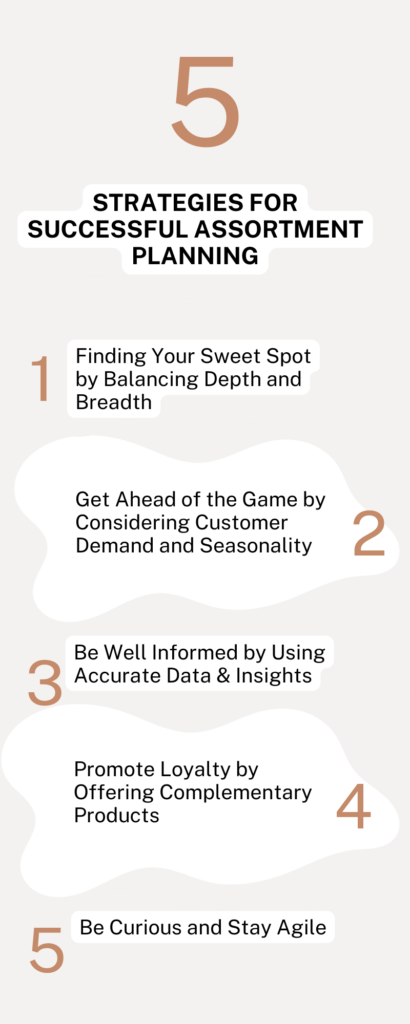Profit Proof Your Products – Your Assortment Planning Guide
BUSINESS STRATEGY / 7 OCTOBER 2024

Assortment planning is a crucial process that can transform the way you manage your retail business. By strategically selecting and organising your product offerings, you can optimise sales, enhance customer satisfaction, and ultimately drive profitability.
When determining the right mix of products for your business, the concept of product assortment plays a crucial role in shaping your customer’s experience and ultimately driving your sales. Product assortment, also known as the merchandise mix, refers to the range of products offered and how those products are varied in size, colour, and category.
A well-executed product assortment strategy ensures your business is memorable, consistent, and profitable, no matter your niche.
Let’s explore the fundamentals with our assortment planning guide and how it can help your business thrive.
What is Assortment Planning?
Assortment planning is the strategic process of selecting the right mix of products to offer your customers. It involves deciding on the depth (how many variations of a product you offer) and breadth (how many categories or types of products) of your merchandise.
Incorporating a customer-centric mindset into your assortment planning is essential. By understanding the needs and preferences of your target market, you can create an assortment that resonates with them. Choosing the right product mix can make the difference between creating a loyal customer base and overwhelming them with too many options. Studies show that when customers are faced with too much choice, they can experience decision fatigue, which often leads to fewer purchases. To get clear on what your customers needs and wants and how they align to their purchasing power for your products consider conducting surveys or focus groups to gather insights in conjunction with data-driven insights.
ASK YOURSELF
- What are the key preferences of my target market?
- How can I align my assortment with customer expectations?
- Am I providing a variety of options without overwhelming my customers?
- When was the last time I conducted a customer satisfaction survey or asked for direct feedback?
Key Benefits of Effective Assortment Planning
- Increased Profit Margins: A well-planned assortment allows you to strategically price your products and maximise profit margins, ensuring that your business remains competitive in the market.
- Enhanced Customer Satisfaction: Tailoring your product selection to match local preferences and trends ensures you meet the specific needs of your customers, leading to increased loyalty and repeat business.
- Increased Sales: A thoughtfully planned assortment resonates with customers, leading to higher conversion rates.
- Reduced Markdowns: By aligning inventory with demand, businesses can minimise excess stock and markdowns.
- Better Inventory Management: Strategic assortment planning promotes more efficient inventory turnover, helping to maintain optimal stock levels. By analysing sales data and market trends, you can identify which products perform best in each location. This targeted approach helps reduce excess inventory and improve cash flow.
Consequences of Poor Assortment Planning
- Overstocking: Excess inventory ties up capital and increases storage costs.
- Stockouts: Frequent out-of-stock items frustrate customers and can lead to lost sales.
- Frequent Markdowns: Excessive discounts can erode profit margins and hurt brand perception.
- Decreased Profit Margins: Inefficient planning directly impacts the bottom line.

Merchandising Models for Effective Planning
An effective product assortment doesn’t happen by chance—it requires a strategic, data-driven approach. By analysing customer behaviour and understanding what products perform best across specific locations, retailers can refine their assortment to meet consumer needs. However, it’s not just about numbers; it’s about aligning your product mix with your brand’s unique vision and values, ensuring every decision supports your core identity while adapting to market demands.
Types of Assortment Planning
To guide you in this process, there are three key assortment planning strategies: Top-Down, Bottom-Up, and Hybrid. Each model serves different business objectives, and understanding their strengths will help you select the approach that fits your brand’s goals and growth stage.
TOP DOWN APPROACH
The Top-Down method starts with a predefined product mix based on historical sales data. By analysing past performance, retailers can streamline their assortments, focusing on attributes or categories that have consistently delivered. This approach works well for established retailers with a wealth of quantitative data and a clear understanding of customer preferences. It’s a reliable method when looking to refine assortments that align with tried-and-tested performance indicators.
Best suited for: Established retailers and brands with robust historical data to draw on.
BOTTOM UP APPROACH
Conversely, the Bottom-Up method focuses on individual products rather than categories, allowing for a more granular response to consumer demands. It thrives on agility and innovation, giving retailers the freedom to experiment and adjust quickly to emerging trends or customer feedback. This method is particularly effective for new businesses or brands that are still gathering quantitative data but have qualitative insights through market research or early customer interactions. It promotes creativity without losing sight of consumer needs.
Best suited for: Newer businesses or brands focused on innovation and real-time market feedback.
HYBRID APPROACH
A Hybrid strategy blends the best of both Top-Down and Bottom-Up, providing the flexibility to personalise customer experiences while still meeting broader company goals. It allows businesses to combine data-driven decisions with an adaptive approach, ensuring that while trends are being considered, the overall vision and values of the brand are not compromised.
Best suited for: Retailers seeking a balance between data analysis and consumer-centric adaptability.
5 Strategies for Successful Assortment Planning
1. Finding Your Sweet Spot by Balancing Depth and Breadth
Understanding the difference between product depth and product breadth is essential.
- Product breadth refers to the number of categories you offer, such as shoes, clothing, or accessories. For instance, a boutique might sell shoes, handbags, and jewellery.
- Product depth refers to the variations within a category, such as different styles, sizes, or colours of shoes. A shoe store might stock several types of boots, sandals, and heels in various sizes.
Retailers can adopt various assortment strategies based on their goals and available store space:
- Deep Assortment: This strategy offers a wide range of products within a specific category, making it perfect for niche markets looking to provide extensive choices to their customers.
- Narrow Assortment: This approach features a limited selection of products, ideal for boutiques with constrained space or a carefully curated offering.
- Wide Assortment: This encompasses a broader range of product categories but with fewer options in each. It’s well-suited for larger retailers or online platforms aiming to provide variety.
Each strategy has unique benefits, influenced by factors like store size, location, and shelf space. Ultimately, no matter which approach you take, the key is to ensure your product selection aligns with customer demand. A successful assortment plan strikes the right balance between the two. Offering too wide a selection can dilute your brand’s identity and increase your inventory costs, while a too narrow range might send customers elsewhere for products they can’t find in your store. Whilst there is no one-size-fits-all approach, it is important to prioritise quality and relevance over an overwhelming variety.
ASK YOURSELF
- Am I offering enough categories to attract my target customers?
- Am I selling out too fast of specific items/categories?
- How can I refine the variations within each category for better focus?
- Do I categorise every product using a grid system?
- Is my current assortment reflecting the brand I want to create in an effective and meaningful way?
2. Get Ahead of the Game by Considering Customer Demand and Seasonality
An often overlooked but critical factor in assortment planning is seasonality and regional demand. Your customers’ needs fluctuate throughout the year, and staying ahead of seasonal trends can boost your sales. For instance, a clothing boutique in Australia should anticipate that the demand for certain categories will differ drastically between summer and winter. The key is to match your product assortment with customer demand while avoiding stockouts or excess inventory.
By planning around seasonal trends or local preferences, you can keep your assortment fresh and ensure you always have the right products available. This also allows you to maintain a steady inventory turnover, optimising space and avoiding the costs of holding unsold stock.
ASK YOURSELF
- How do seasonal trends impact my sales?
- Am I planning an even product life cycle across all products and categories?
- Are there specific local preferences I should consider in my assortment?
- Am I prepared for changes in demand during peak seasons?
- What is my exit strategy if the sales don’t meet my planned expectations?
3. Be Well Informed by Using Accurate Data & Insights
Your inventory and customer data are invaluable when it comes to optimising your product assortment. By closely analysing sales trends, you can identify which products are consistently performing well and which ones aren’t gaining much traction. Understanding what sells best in each location allows you to make informed decisions. This insight allows you to make informed decisions about increasing stock for high-demand items while scaling back or discontinuing those that don’t resonate with your customers.
When you combine sales tracking with customer behaviour—like how often they buy, their browsing habits, and seasonal trends—you’ll get a much clearer picture of what’s in demand. It’s all about regularly reviewing how things are performing and adjusting your forecasts based on what you find. For example, if you notice certain sizes or colours are always selling out, that’s a strong signal to re-adjust your sizing curve and invest more depth in those sizes. On the flip side, if products are moving slowly, it could highlight a lack of interest, product visibility or a pricing issue, giving you the chance to rethink your strategy. By using data as your guide, you can fine-tune your assortment to better align with what your customers want, improve stock management, reduce wastage, and maximise profits.
ASK YOURSELF
- How often are you tracking the performance of your products?
- Are there certain product categories that consistently outperform others?
4. Promote Loyalty by Offering Complementary Products
Enhancing your assortment can sometimes be achieved through complementary products. This doesn’t necessarily mean dramatically expanding your range but finding products that align well with your core offering. For example, a boutique that sells high-end shoes might add leather care products, specialty insoles, or socks. These items not only complement the main purchase but also increase the customer’s basket size, resulting in higher sales per transaction.
ASK YOURSELF
- What complementary products can enhance my primary offerings?
- How can I create product bundles that encourage customers to spend more in one single transaction?
- Are there brands or items I can collaborate with to fill any gaps in my assortment?
5. Be Curious and Stay Agile
The retail landscape is continuously changing, and it’s essential to keep your product assortment flexible to respond to shifting trends. While it’s important to remain aware of emerging trends, it’s equally crucial not to lose sight of your brand’s core vision, purpose, and values. Finding that balance allows you to adapt without wavering from what makes your brand unique. Monitor market shifts and emerging trends, but ensure they align with your identity and messaging.
ASK YOURSELF
- What emerging trends should I be monitoring for my market?
- Am I agile enough to adapt my assortment quickly to changing demands?
- How can I stay informed about market shifts and customer behaviours while remaining true to my brand’s core values?
To bring it all together, successful assortment planning is both an art and a science. It requires a deep understanding of your market, clear insights from data, and an ability to anticipate future trends. A well-curated product mix can foster loyalty and increase sales by offering a selection that speaks directly to your audience’s needs and lifestyle. Transforming your business through effective assortment planning requires a combination of data analysis, collaboration, and customer understanding. By adopting these cutting-edge techniques, you can maximise profits, meet market demand, and create a more efficient and responsive retail operation.






Read the Comments +